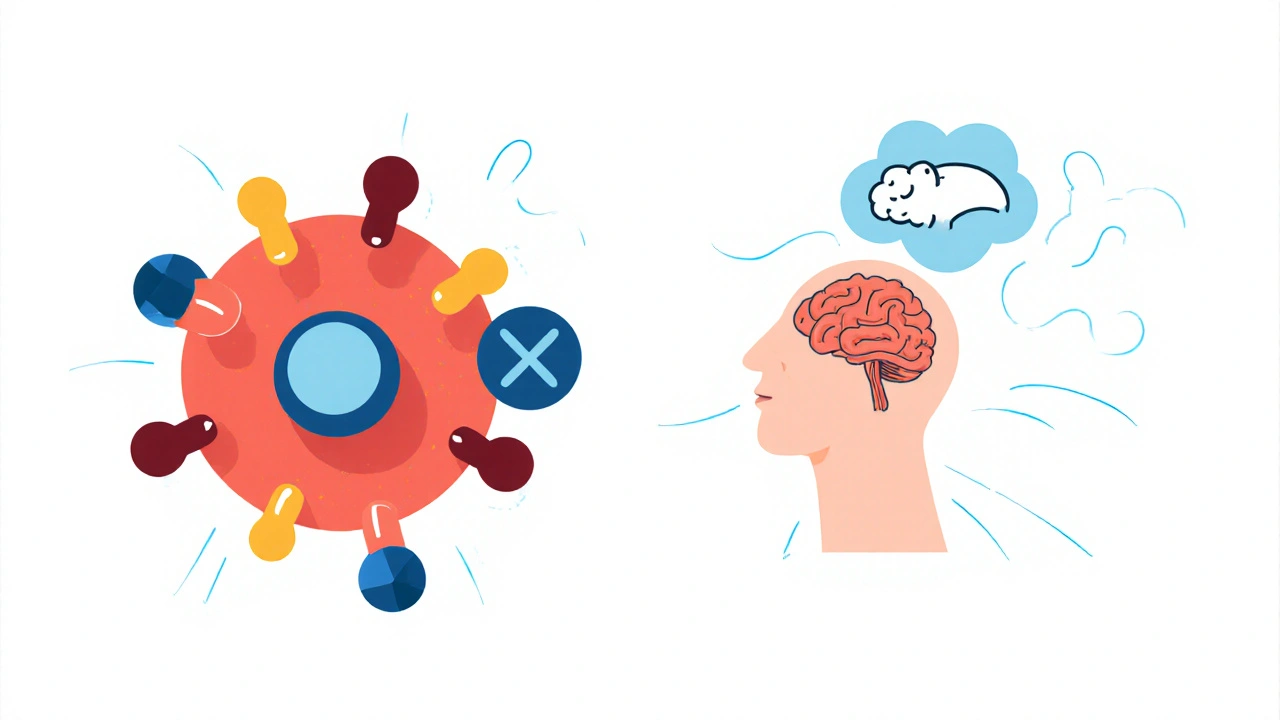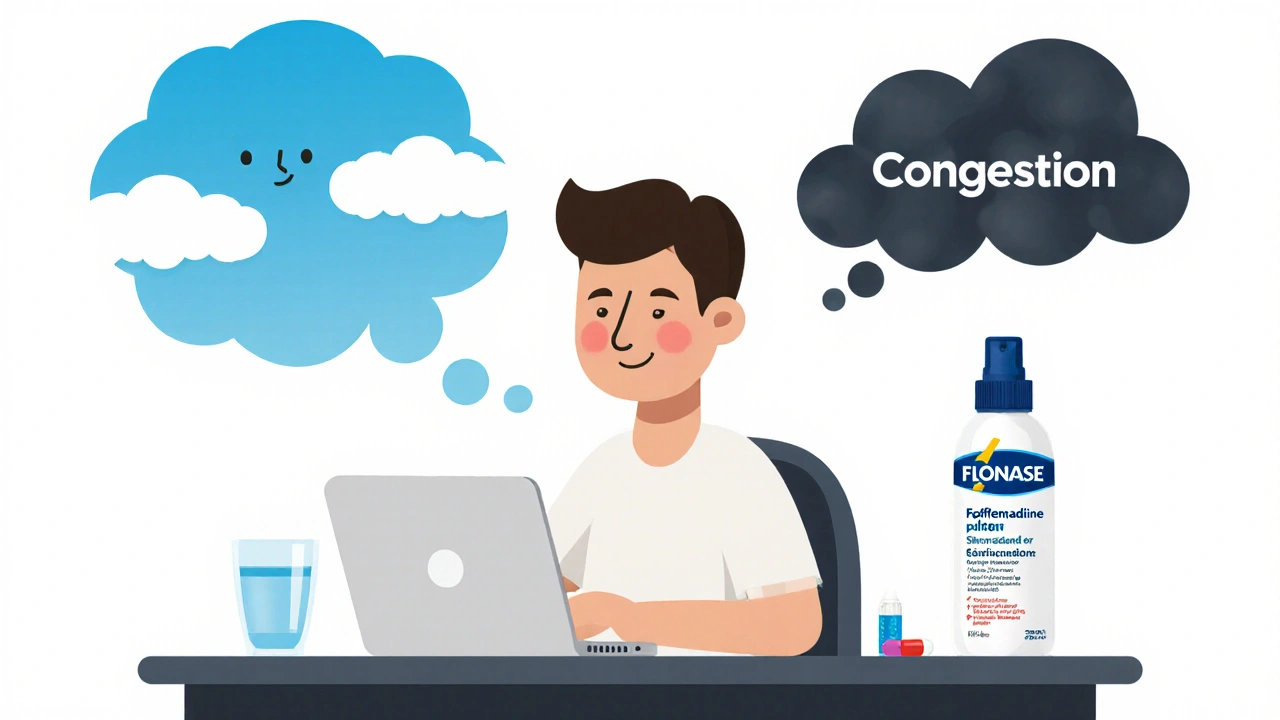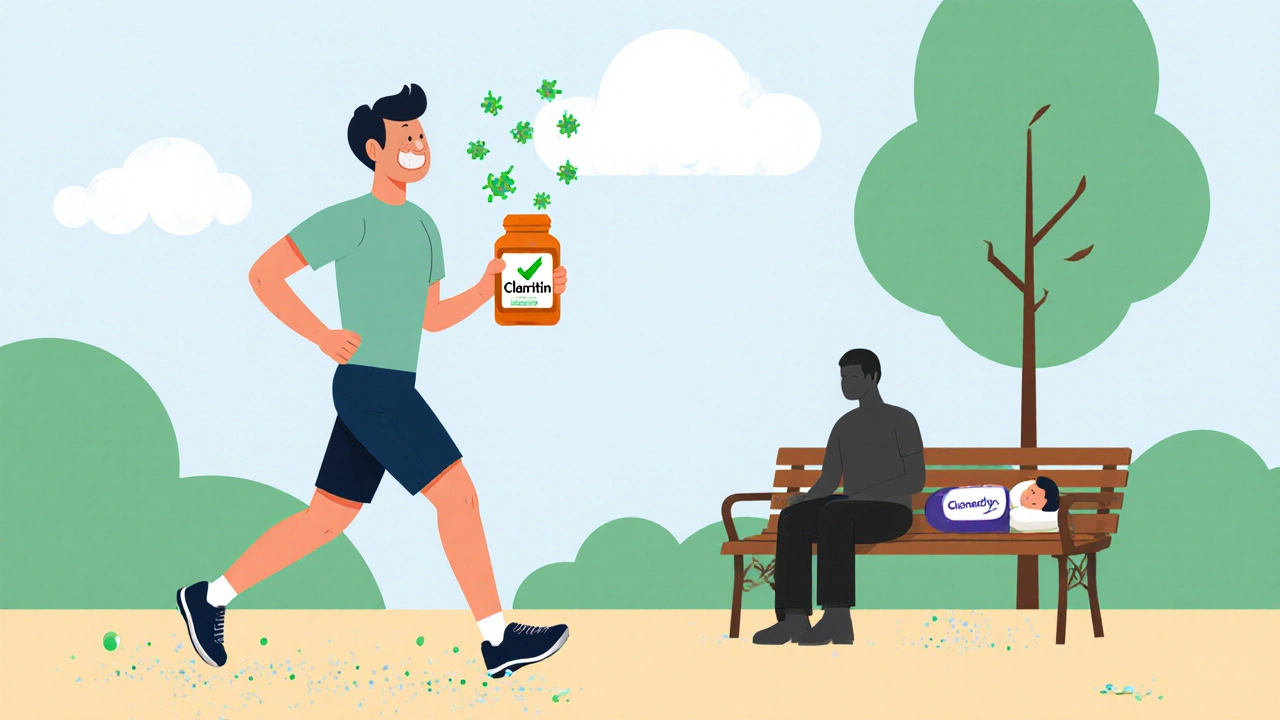When your nose runs, your eyes itch, and you feel like you’re stuck in a never-ending sneezing fit, you reach for an antihistamine. But not all antihistamines are the same. If you’ve ever taken diphenhydramine (Benadryl) and felt like you were drugged for the rest of the day, you’re not alone. That’s why millions of people now choose second-generation antihistamines - the smarter, safer option for daily allergy relief.
Why First-Generation Antihistamines Are Out of Style
First-generation antihistamines like diphenhydramine and chlorpheniramine were the go-to for decades. They work - fast. But they also cross the blood-brain barrier easily, which is why they make you sleepy, dizzy, or foggy-headed. Studies show up to 60% of people who take these feel drowsy. Imagine trying to drive, work, or pick up your kids after taking one. Not ideal. These older drugs also dry out your mouth, blur your vision, and sometimes cause constipation or urinary issues. They’re short-acting, too - you need to take them every 4 to 6 hours. That’s why, by the 1990s, doctors and patients started looking for something better.What Makes Second-Generation Antihistamines Different?
Second-generation antihistamines like loratadine (Claritin), cetirizine (Zyrtec), and fexofenadine (Allegra) were designed to fix the biggest problem: drowsiness. They’re built differently. Their molecules are larger and more polar, which means they can’t easily slip into your brain. Instead, they stick to histamine receptors in your nose, skin, and throat - exactly where allergy symptoms happen. This small change makes a huge difference. Clinical trials show sedation rates drop from 50-60% with first-gen drugs to just 6-14% with second-gen. That’s an 80% reduction in drowsiness. And because they last longer - 12 to 24 hours - you only need one pill a day. No more midday naps because of your allergy meds.How They Work: A Look at the Science
Recent research using cryo-electron microscopy has shown exactly how these drugs bind to the H1 receptor. They latch onto a deep pocket in the receptor, blocking histamine from triggering the allergic response. What’s fascinating is that they don’t just block histamine - they lock the receptor in place, preventing it from switching on at all. This precision is why they’re so effective without causing brain fog. Fexofenadine, for example, is barely metabolized by the liver. About 95% of it leaves your body unchanged, mostly through your kidneys and bowels. That’s why it’s less likely to interact with other medications. Loratadine and cetirizine are processed by the liver, but even then, they’re much safer than the old drugs like terfenadine, which was pulled from the market in the 90s for causing dangerous heart rhythms.Real-World Effectiveness: What Users Actually Say
On WebMD, cetirizine has over 12,000 reviews with a 4.2 out of 5 rating. Most people say it works great for sneezing and itchy eyes. But here’s the catch: 23% still report feeling a little sleepy. That’s higher than clinical studies suggest, and it’s probably because some people are more sensitive - or take it with grapefruit juice, which can interfere with how it’s processed. Reddit users in r/Allergies say the same thing: “Fexofenadine doesn’t make me sleepy like Benadryl, but I still need Flonase for my nose.” That’s a common theme. Second-gen antihistamines are excellent for itching, runny nose, and sneezing - but they’re not great for nasal congestion. If your nose is stuffed up, you’ll likely need a decongestant or nasal spray on top of your antihistamine. One user on Drugs.com had a bad reaction to loratadine - severe headaches for three days. Switched to cetirizine, and it worked fine. Everyone’s body reacts differently. That’s why many people try two or three before finding their sweet spot.
What They Don’t Do - And Why That Matters
These drugs are not magic bullets. They won’t help with colds. Studies from Johns Hopkins show they don’t reduce sneezing in viral infections like the common cold. That’s because colds involve more than just histamine - they trigger inflammation and other chemicals that second-gen antihistamines don’t block. First-gen drugs, which also act on acetylcholine receptors, can help a bit with cold symptoms - but they come with the drowsiness trade-off. They also don’t fix congestion. If your nose is blocked, you’re probably going to need something like pseudoephedrine or a steroid nasal spray. That’s why products like Allegra-D exist - combining fexofenadine with a decongestant. But even then, you’re managing two different problems with two different drugs.Choosing the Right One for You
Here’s a quick breakdown of the top three:- Loratadine (Claritin): Least likely to cause drowsiness. Good for mild allergies. Works best if taken daily during allergy season.
- Cetirizine (Zyrtec): Fastest acting. Strongest for itching and hives. Slightly more likely to cause drowsiness - about 1 in 5 people feel it.
- Fexofenadine (Allegra): Least likely to interact with other meds. Doesn’t cause drowsiness in most people. Best if you’re on other medications or have liver concerns.
When and How to Take Them
For best results, take them before exposure. If you know you’re heading into a park with high pollen, take your pill 1-2 hours before. Studies show this cuts symptoms by 40-50% compared to taking it after symptoms start. Don’t take fexofenadine with fruit juice - apple, orange, or grapefruit juice can reduce its absorption by up to 40%. Stick to water. Also, avoid alcohol. Even though these drugs don’t make you sleepy like Benadryl, mixing them with alcohol can still make you feel off.
Side Effects You Should Know
Most people have no issues. But here’s what some report:- Headaches (38% of users on Drugs.com)
- Strange taste (metallic or bitter - 12% on Reddit)
- Mild stomach upset
- Occasional drowsiness (especially with cetirizine)
What’s Next? The Future of Allergy Relief
Scientists are already working on the next generation. In early 2024, researchers found a second binding site on the H1 receptor. That means we might soon have drugs that are even more targeted - blocking histamine without touching anything else. One new drug, bilastine XR, is being tested as a once-a-week pill. That could help the 37% of people who forget to take their daily meds. Climate change is making allergies worse, too. Pollen counts are rising. By 2050, they could be 25-30% higher. That might mean higher doses or more frequent use of these drugs in the future. But for now, second-gen antihistamines are still the gold standard.Bottom Line: Are They Worth It?
Yes. If you want to manage allergies without feeling like a zombie, second-generation antihistamines are your best bet. They’re safe, effective, and designed for real life - work, school, driving, parenting. They don’t fix everything (congestion still needs help), but they solve the biggest problem: drowsiness. Start with loratadine. If it doesn’t work, try cetirizine. If you’re on other meds or want the cleanest profile, go with fexofenadine. And if your nose stays stuffed? Add a nasal spray. You don’t need one miracle pill - you need a smart plan.Millions of people use these daily. You don’t have to choose between feeling awful or feeling drugged. There’s a better way.
Are second-generation antihistamines safe for long-term use?
Yes. Studies tracking loratadine, cetirizine, and fexofenadine for over 20 years show no increased risk of liver damage, heart issues, or dependency when taken as directed. They’re designed for daily use during allergy seasons and are considered safe for years of use in adults and children over age 2.
Can I take second-generation antihistamines with other medications?
Most are safe, but check with your doctor if you’re on antibiotics, antifungals, or heart meds. Fexofenadine has the fewest interactions because it’s not broken down by the liver. Cetirizine and loratadine can interact with drugs that affect the CYP3A4 enzyme, like ketoconazole or erythromycin. Always review your full list of meds with a pharmacist.
Why does cetirizine make me sleepy when others don’t?
Cetirizine is slightly more likely to cross the blood-brain barrier than loratadine or fexofenadine - even though it’s still much less than first-gen drugs. About 1 in 5 people are more sensitive to this effect. If you feel drowsy, try switching to fexofenadine or taking cetirizine at night instead of in the morning.
Do these antihistamines work for pet allergies?
Yes. Second-generation antihistamines are effective for pet dander, pollen, mold, and dust mites - all common triggers. They reduce itching, sneezing, and runny nose caused by these allergens. For best results, combine with regular cleaning and air filters.
Is it okay to take these every day during allergy season?
Absolutely. Many allergists recommend daily use during peak seasons - especially for allergic rhinitis. Taking them consistently prevents symptoms from starting, rather than waiting until you’re already suffering. Studies show daily use is more effective than on-demand dosing.
Can children take second-generation antihistamines?
Yes. Loratadine and cetirizine are approved for children as young as 2 years old, and fexofenadine for those 6 and older. Dosing is based on weight and age. Always check the label or ask your pediatrician. These are much safer for kids than first-gen options, which can cause hyperactivity or sedation.


Post A Comment